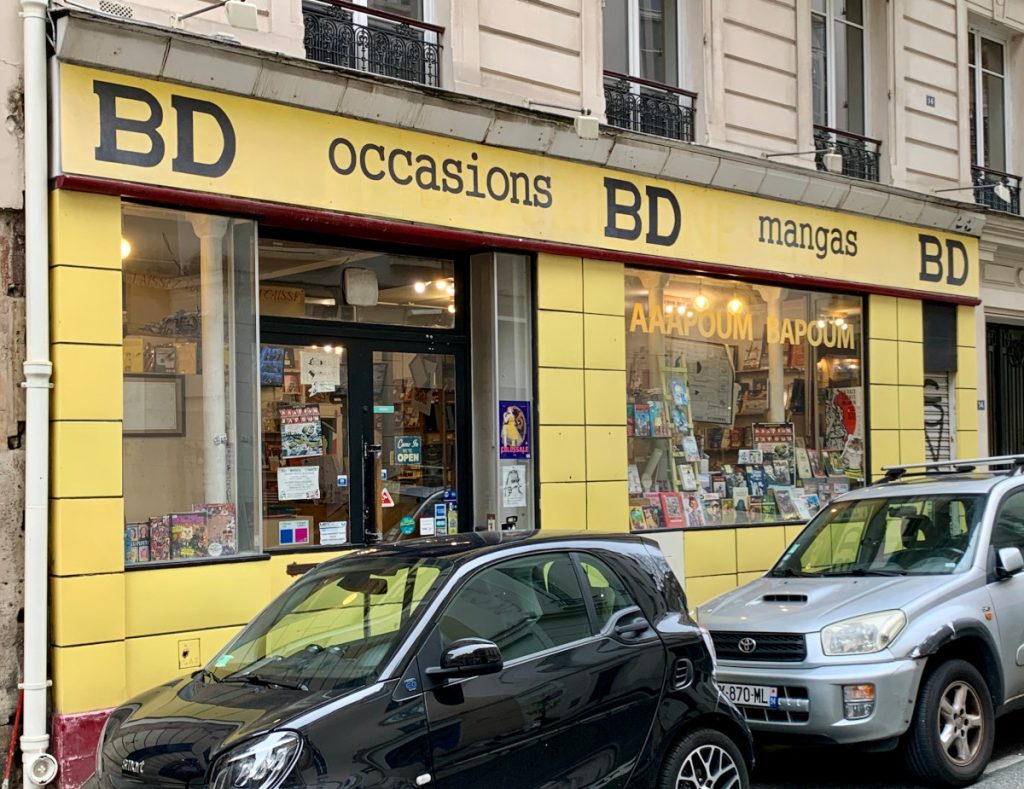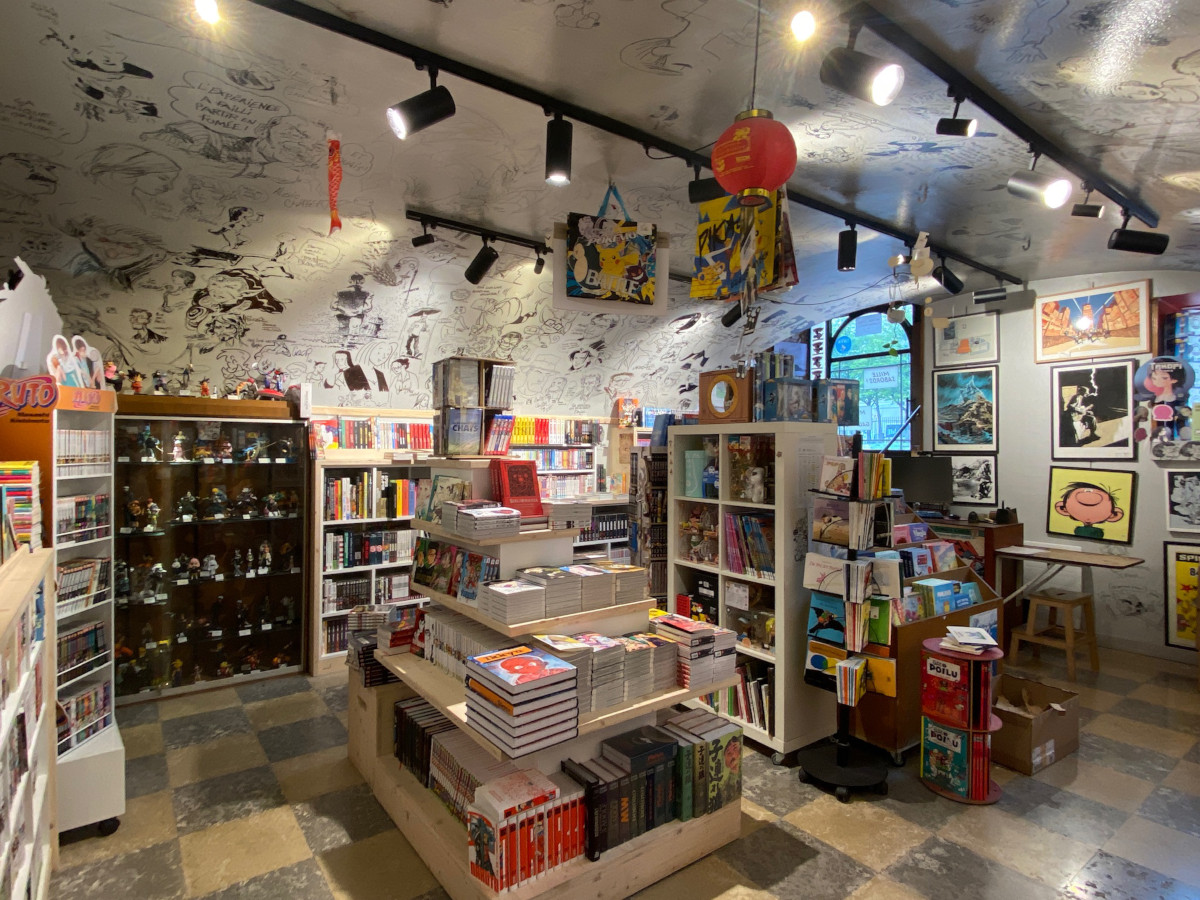I went to France for a vacation. It was like going to a different world for comics.
Walking into Aaapoum Bapoum, a comic shop located in Paris, France’s Latin Quarter, you can’t help but feel like you’re entering an entirely differently world for the medium. 32
You step in and find a perfect fusion of an impeccably curated bookstore, a lovingly laid out museum of sequential art, and a tour into the minds of each employee who has worked at the shop. It’s a domain of transactions and sales, of course. But it’s also more than that. As François Hercouet, the Editorial Director of Urban Comics – the France-based publisher of DC, Image, and BOOM! comic translations, amongst others – put it to me, Aaapoum Bapoum is a “holy place.” It’s a widespread celebration of the comic art form under one roof, no matter if you’re talking bandes dessinées (or BD), 33 Batman, or Berserk.

While Aaapoum Bapoum is a top tier shop in France and a one-of-a-kind example of the form, it doesn’t exist in a vacuum. It’s a reflection of France’s relationship with sequential art. France loves comics. It loves BD. It loves Tintin. It loves Emil Ferris. It loves manga. 34 It loves it all. France is a comic country, albeit one of a slightly different shape and form as the United States.
During my recent three week visit to France, I couldn’t help but find comics. Comics in shops like Aaapoum Bapoum or hole-in-the-wall emporiums like Lyon’s Boul’dingue. Comics in Aix-En-Provence’s everything market or in L’isle-Sur-la-Sorgue’s vaunted Easter antiques fair. Comics in train stations, comics in window displays, comics on the Paris Metro, comics in museums, comics everywhere. At one point, my wife openly wondered if these “unplanned visits” to comic-related locations weren’t so unplanned. That wasn’t the case. The medium and art form are just so ubiquitous in the country that happy accidents are always right around the corner.
That experience was an eye-opener, and one I wanted to write about. There’s a lot of wondrous things about France’s relationship with comics, and plenty that could be learned from all of it. So, today, I’ll be sharing some of the observations made during that visit, and maybe – just maybe! – there will be some actionable items in there that the American market could learn from in the process. Or maybe you’ll just learn a little bit about how another country does this whole thing. One of the two!

France’s relationship with the medium is much different
Before we get into any of the saucier observations, one crucial point needs to be emphasized, and that’s just how dissimilar France’s feelings towards the comic book art form are compared to America’s. The main difference between each’s relationship with the medium is simple. While America sees plenty of success with comics and graphic novels, it still often battles questions about the legitimacy of the medium amongst certain audiences. That’s not the case in France. This country doesn’t just love comics; it’s in love with comics. There’s broad acceptance of the art form, and that’s reflected by who visits France’s comic shops: everyone.
In my two visits to Paris’ comic shop Aaapoum Bapoum, you were equally likely to find people like me digging through single-issue comics and younger folk browsing manga as you were to witness middle-aged women looking for translated American comics and thirty-something couples gleefully exploring racks of highbrow BD. Comics are an art form for the people of France, and one that isn’t looked down on by some as lesser than simply because they contain pictures as well as words.
A fun example of that came at our Airbnb, a little cottage on the same grounds as the family home, outside of Aix-En-Provence in the south of the country. When my wife and I were browsing the welcome guide our hosts created, I noticed a message within. It said that if anyone was interested, they had an extensive collection of comics available for browsing or borrowing. The sprawling collection of BD belonged to their twenty-something son, and each member of this lovely, erudite family delighted in it. When I asked our host if I could check them out, 35 they were equal parts flabbergasted and overjoyed. In all their time welcoming people onto their property, I was the first to ever ask to see the collection. Which is too bad. It was an incredible assemblage of comics and art, and the family took joy in walking me through them and discussing their favorites.
That experience was a microcosm of what we would see each day of our journey. France as a country is very much about celebrating the art form, no matter where you go.
Taking a train out of Paris’ Gare de Lyon, Aix-En-Provence’s TGV station, or Lyon’s Part-Dieu? You’ll find murals celebrating 50 years of the renowned Angoulême International Comics Festival, with the event, cartoonists who participated, and their art celebrated in a series of images on the walls of those stations — to say nothing of a plethora of manga, BD, and comics for sale in convenience stores at the stations. Going to a convention like Paris Fan Festival? You’ll discover an event that’s all about fandom and energy and the love of whatever thing you’re into, whether that’s comics, art, or games. Hitting up a local comic shop? It isn’t just about selling wares but covering every square inch of the location with art and comics. We even came across a lovely exhibit and mural celebrating the art and life of Kim Jung Gi in the otherwise bizarre Musée Cinéma et Miniature in Lyon. Comic art is everywhere!
As a country, as a people, as a society, France is giddy about comics. The burn out that is so often felt by American fans is completely absent in my admittedly limited experience. They love comics. That colors every aspect of how the medium is approached in the country. 36
subscribers only.
Learn more about what you get with a subscription
Which is why my expression in the header image above is so apt. That’s a random shot my wife caught of me as we walked through the shop for the first time.↩
Which is what comics originating in France are largely called.↩
Boy does it love manga!↩
What am I going to do, not look at the comics they have?!↩
Like with anything tourism related, I almost certainly am looking at this with rose colored glasses on, only having a surface level view of how things really work. But it’s how it seemed!↩
Which is why my expression in the header image above is so apt. That’s a random shot my wife caught of me as we walked through the shop for the first time.↩
Which is what comics originating in France are largely called.↩
Boy does it love manga!↩
What am I going to do, not look at the comics they have?!↩
Like with anything tourism related, I almost certainly am looking at this with rose colored glasses on, only having a surface level view of how things really work. But it’s how it seemed!↩
*Points to any number of titles on my bookshelf with an inconsistent layout of volume number and publisher name on the spine.*↩
Often, not always.↩
This concept once existed in America, but near as I can tell it only lasted for 11 volumes and only collected a fraction of what these editions did.↩
BD is no problem. It’s rather straight forward in terms of where to start.↩
Even figuring out which title belongs to which character family is easy, as Urban color codes the titles of its DC releases to match those characters. i.e. Green Lantern is green, Batman is gray, etc.↩
It’s probably very difficult.↩
More on this in the penultimate point.↩
Save for Phase Four, really.↩
Which, as my wife noted, is helpful for those who are really just looking for a certain type of story rather than a specific BOOM! title or something.↩
Which included the first volume of a wide variety of titles for customers looking for where to start.↩
For example: I’ve been looking for a collection of Daredevil: Born Again for months to buy my pal Brandon, and in that time, I’ve found zero non-severely marked up English collections while nearly every shop I went to in France had at least one.↩
To underline just how big of a deal comics are in France, Momie Lyon is actually a series of six shops that take up half a block on the massive pedestrian street Rue Victor-Hugo, each of which specializes in some different nerd emphasis.↩
Which was part of the same Momie empire Momie Lyon is part of, although not quite as effective at what it does.↩
Good examples include Big Bang Comics in Dublin, Austin Books & Comics in Austin, Texas, Floating World in Portland, and Books with Pictures in Portland, at least amongst shops I’ve visited.↩
One had so many that it seemed genuinely dangerous for the person and the comics involved to do so without some sort of basket.↩
Those two are a part of quartet of manga shops on just that one admittedly humongous street.↩
And buy said comic which I cannot read, which I did!↩
The rest, interestingly enough, included many, many English language translations, including “Environment Toxique,” a new release that was the French edition of Kate Beaton’s Ducks: Two Years in the Oil Sands. I loved seeing translated titles in France.↩
I did not push my perspective. It was just interesting to hear what he thought.↩
It seems like the true number is somewhere in the 6 to 8% range.↩
To the point that it’s so large it has to be racked with BD releases.↩
Which is why my expression in the header image above is so apt. That’s a random shot my wife caught of me as we walked through the shop for the first time.↩
Which is what comics originating in France are largely called.↩
Boy does it love manga!↩
What am I going to do, not look at the comics they have?!↩
Like with anything tourism related, I almost certainly am looking at this with rose colored glasses on, only having a surface level view of how things really work. But it’s how it seemed!↩
